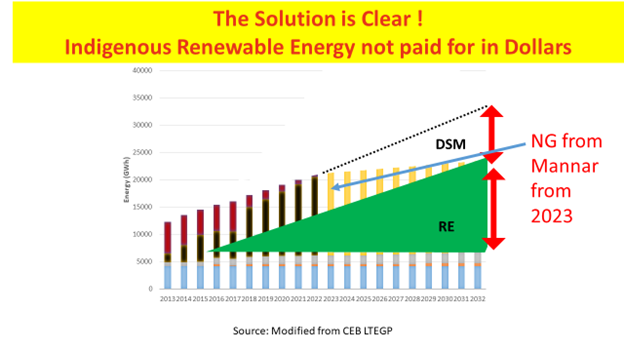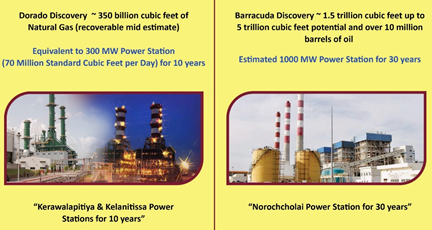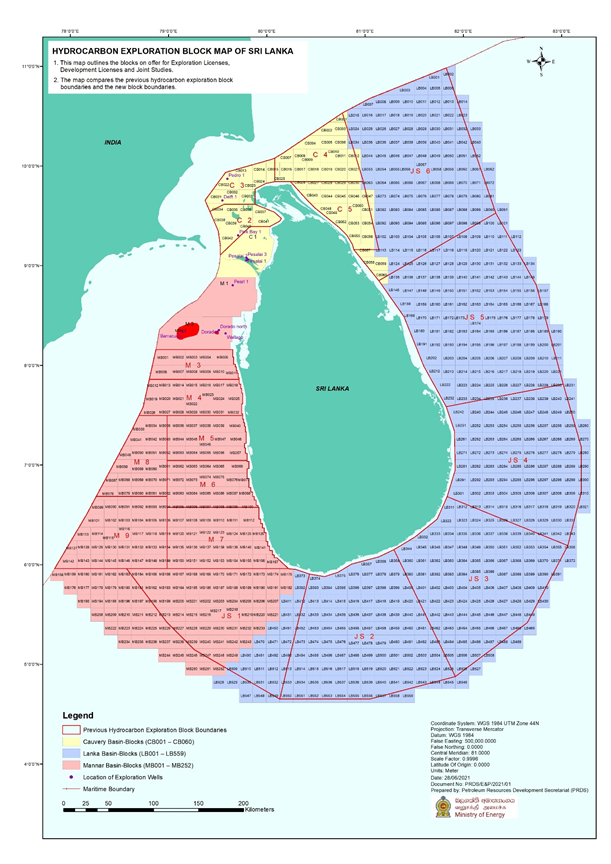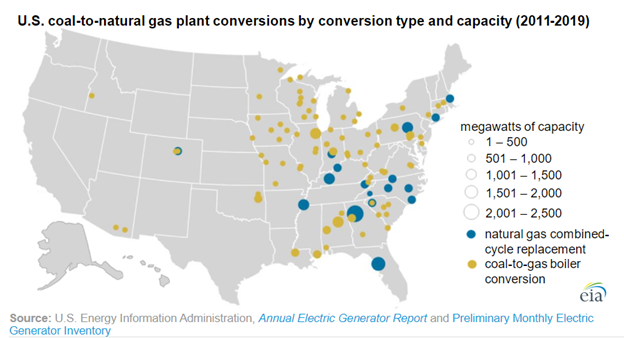A Productive Way out of the LNG Dilemma!
Eng Parakrama Jayasinghe
Both Liquid Petroleum Gas (LPG) which has become the preferred cooking fuel even in some rural areas, which saw a heavy price hike recently, and now Liquefied Natural Gas (LNG) yet to be used, have received widespread attention of the public.
Natural Gas (NG) , which is mostly Methane (CH4) , which is the fossil fuel promoted as the alternative for the dirty coal used for power generation, has to be brought in to the country in concentrated form and liquefied at low temperature for transport logistics and economies , which makes it LNG, when the source of supply is from abroad. We will therefore have to depend on LNG as long as it is imported and also would need the storage and regasification facilities such as the Floating Storage and Regasification Units (FSRU) to convert the LNG to the form usable at a power plant. These are the issues under hot debate right now.
Ignoring the sordid details of the major decision making processes of Sri Lanka, particularly in the energy sector, let us face the realities
- A 350 MW power plant designed to be using natural gas is being built, without any arrangements in place for the supply of the gas needed.
- The 300 MW Yugadhanawi power plant pushed as being designed for easy conversion for the use of Natural Gas, has been running on low sulfur furnace oil as expensive as diesel, since 2011.
- The natural gas price in the world is soaring , compared to the situation when it appeared as the best option to get away from Coal
- The Renewable Energy based electricity is now undoubtedly cheaper than any form of fossil fuel based generation including NG , and this is true in Sri Lanka too.
- There is a proven indigenous natural gas reserve in Mannar in Blocks M2 in close proximity to the 900 MW Norochcholai coal power plant
- Coal prices have gone through the roof, making coal power once considered the cheapest when all of its ill effects are ignored, is no longer an option, both financially, economically and environmentally and socially
- Sri Lanka has declared a policy to achieve a 70% contribution by RE sources for electricity generation by 2030, and an international commitment to reach zero carbon emission status by 2050
- There is a significant interest backed by actual commitments and multi million dollar investments for the purchase of the Mannar data, by big players in the Oil and Gas industry targeting the balance blocks for exploration offered by Sri Lanka. This process is underway, supported by an immediate captive demand for the proven sources to be developed
- Sri Lanka is in the throes of a foreign exchange crisis, which makes an offer of US $ 250 Million to appear as manna from heaven. However the annual drain of over $ 4000 Million for the import of fossil fuels, of which nearly $ 1000 Million is consumed for power generation, is the main contributor to the crisis, which is exacerbating by the current world trends.
- In the government sector the left hand does not seem to know what the right hand is doing
- Thus a national asset in a company making good profits is being sold by the Treasury who own the shares, accepting conditions gravely affecting the performance of the Ministry of Power and Energy and the plans and programs of the Ministry of Energy, without any consultation with them, in a mid-night deal.
In this background it is worthwhile to consider if there is still a way out and to eat the cake and keep the cake, which can be shown to be still possible.
The Current State of Play in the Electricity Sector.
There has been dooms day predictions of impending energy shortages in the past, most recent being in 2019, which did not come to pass. The next prediction is predicted for 2023, unless the present dependence on imported fossil fuels is arrested, this prediction many come true, not because of lack of generation capacity, but due to the inability to pay for the import of fossil fuels both oil and coal.
There has been some progress in the development of Renewable Energy, which are, fortunately for Sri Lanka are also indigenous, and none fuel based in case of wind and solar. Some impediments imposed by vested interests on this progress has now been removed by the present administration and coupled with the laudable target to achieve 70% RE contribution by 2030, would help accelerate this progress. This goal clearly limits the space available for none renewable power generation. As the table below indicates there is no room to add any more fossil fuel based power plants including Natural Gas, except perhaps as replacement for the units due to be retired shortly at the end of their economic life.
Notes.
- Projected total electricity demand in 2030
- Fossil fuel generation allowable under 70% RE scenario
- Renewable Energy Capacity to be reached by 2030 to achieve 70% RE target
Therefore the 350 MW Sobhadhanwi Power Plant may have a role to play, as several plants in the Kelanitissa complex are due to be retired.
Although the commitment to achieve zero emission status by 2050 would impose a further challenge to reach carbon free power generation by 2040, being a major contributor to the carbon emissions. The introduction of natural gas (NG) as a transition source of fuel to occupy the 30% space up to 2030 and beyond, which presently stands at 9000 GWH and perhaps even larger volumes up to 2040 based on the increasing demand predictions in the interim.

The Game Plan
 As stated above there is no room for adding any more NG power plants at Kerawalapitiya or for fuel switching at Kelanistissa, proposed as the means of absorbing the minimum Take or Pay (TOP) condition of 35 Million MBTU per year in the present deal with New Forest Energy ( NFE) . Therefore the suggestion that we will only pay for the 25 Million MBTU per year that we can consume, during the first five years and the balance would be accumulated, but nevertheless is payable, will be a Damocles Sword hanging over us. This would also be a strategy to extend the contract for a further five year period. It is futile to make calculations of the amount we have to pay, for something we will not consume at present, as the crystal ball is quite cloudy as to the rate at which the NG prices would escalate. The recent price trends shown below is a good indication.
As stated above there is no room for adding any more NG power plants at Kerawalapitiya or for fuel switching at Kelanistissa, proposed as the means of absorbing the minimum Take or Pay (TOP) condition of 35 Million MBTU per year in the present deal with New Forest Energy ( NFE) . Therefore the suggestion that we will only pay for the 25 Million MBTU per year that we can consume, during the first five years and the balance would be accumulated, but nevertheless is payable, will be a Damocles Sword hanging over us. This would also be a strategy to extend the contract for a further five year period. It is futile to make calculations of the amount we have to pay, for something we will not consume at present, as the crystal ball is quite cloudy as to the rate at which the NG prices would escalate. The recent price trends shown below is a good indication.


As such depending on imported natural gas which makes it LNG is not an option we should pursue, if not for any reason other than the drain on the foreign exchange.
Do we have an option? Fortunately based on the opinion of the officials of the Petroleum Development Authority of Sri Lanka (PDASL) now formally established under the Act no 21 of 8th October 2021, we do have a more attractive option. The hard work of these officials who never lost faith in spite of setbacks, unequivocally confirm the proven resources in the Block M2 in Mannar named Barracuda and Dorado of the presence of almost 1.85 Trillion Cubic Feet of Natural Gas (mid-level estimate). This is equivalent to 1850 Million MBTU, to be compared to the present numbers being bandied about, of 175 Million MBTU over five years as the TOP offered by the NEF. There is adequate gas to operate these two power plants for over 50 years from this one gas field alone.

The prospectively of the wider Mannar Basin, inc. Block M2, is estimated to hold 9 TCF of Natural Gas based on analysis of all available data. (Ref. PDASL model below)


So we can operate the Norochcholai, Yugadhanawi and Sobhadhanawi power plants for 30 years with our own gas, if we take the trouble to develop these two reservoirs alone.
But naturally we do not have the expertise or the economic capacity to develop this resource and would need a competent company in the Oil and Gas industry to come to a contractual arrangement with Sri Lanka. May I mention in passing that I hope these negotiations will be done by competent people who have interest of Sri Lanka as the utmost aim, while accepting the realities of the commercial world?
Take or Pay for Natural Gas Development in Mannar
As much as a supplier of an FSRU and supply of LNG would expect a minimum guaranteed off take, the potential developer of our own gas fields would also have similar expectations, which we cannot deny. It is up to Sri Lanka to evaluate the minimum quantities we can afford to consume without having to pay for gas or services beyond that amount. This becomes even more critical when that payment will need to be in Dollars that we don’t have.
It has often been said that the minimum offtake that would be acceptable would be in the range of 1000 MW of power generation. This is verified by the NFE terms which targets the two plants at Kerawalpitiya adding up to 650 MW and the passing references to another power plant of capacity 350 MW at the same location, which has not received much attention. It is clear that this cannot happen if we accept the 70% RE target.
But how can we reach the 1000 MW target but not violate the 70% RE target? Fortunately the recent events have opened a most attractive opportunity to offer a viable level of off take without having to construct any new power plants. The phenomenal rise in the Coal prices now exceeding $ 240 per MT at source, could be a blessing in disguise in many ways. No amount of fancy accounting can now prove the cost of coal power generation to be at an acceptable level, even if we can find the dollars to buy the coal.
So the most obvious step to be taken is to covert the three units of 300 MW coal power plants at Norochcholai to operate on natural gas, from our own gas resources. Not only this does not require any FSRUs, as the gas will be supplied in gaseous form, which can be pumped directly to the power plant, we will not have to pay for the gas in Dollars. There would be some payment on the extraction, processing and piping costs. But this is not linked to any world gas prices. However, the benefits that would accrue, financially, economically and environmentally are massive and too numerous to list here.
Before any one objects to this proposal by saying that this is not proven technology or has not been done anywhere, I refer to the chart below where over 100 coal plants have been converted to gas in USA alone.

No doubt this kind of leap would require much planning and analysis in addition to the political wisdom and will. Some temporary measures would need to be taken if the planned time schedules are disturbed. But the realities on the ground and the dire situation faced by Sri Lanka presently and in the foreseeable future, behooves us to look for innovative solutions and maximize the utilization of our own resources that nature has bestowed on us.
But as mentioned before, the principle ingredient required is the commitment to achieve the best for Sri Lanka and the integrity of the decision makers. These unfortunately has been the missing ingredients in all of the past events.
I await responses from those who can appreciate the validity and value of these proposals, as well as those from the doubting Thomas’s to which I will respond, as the space limits me to preempt such queries.
Has Sri Lanka got the courage to reject the current proposals driven by short term expediencies and may be other reasons, which will definitely block any chances of Sri Lanka chances of ever developing our proven resources and take this step to make us a net energy exporter?
 Eng. Parakrama Jayasinghe is a Chartered Mechanical Engineer with a BSc Eng (honours) degree from the University of Peradeniya. He is fellow of the Institution of Engineers Sri Lanka and a Member of the Institution of Mechanical Engineers London.
Eng. Parakrama Jayasinghe is a Chartered Mechanical Engineer with a BSc Eng (honours) degree from the University of Peradeniya. He is fellow of the Institution of Engineers Sri Lanka and a Member of the Institution of Mechanical Engineers London.




